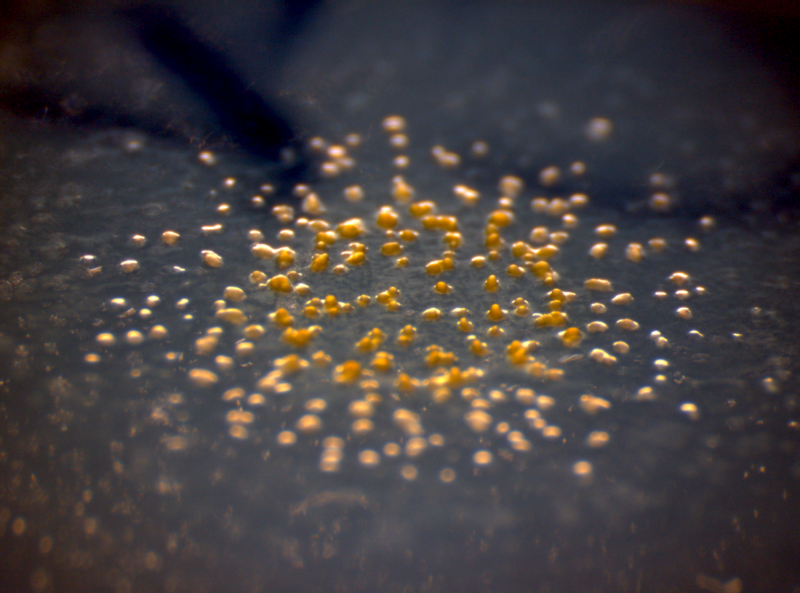July 7, 2015 report
Researchers uncover new clues to help explain kin discrimination

(Phys.org)—A team of researchers with affiliations to institutions in the U.S., Germany and Switzerland has taken another step towards understanding kin discrimination—at least as it applies to a type of bacteria. In their paper published in Proceedings of the National Academy of Sciences, the group describes experiments they conducted with Myxococcus xanthus, a type of bacteria, and what they found in doing so.
Prior research with M. xanthus, found that if two genetically identical colonies were put on a glass plate a small distance from one another, they would gravitate towards one another and form a large single colony. When two colonies that were not genetically identical were placed on the glass, they did not merge—a clear example of kin discrimination, where an organism favors those that are genetically the same. In this new effort, the researchers took the study a bit further by introducing another factor.
When undergoing periods of a lack of food, M. xanthus create fruiting bodies, which release hardy spores—the spores are able to go without food for a longer period of time, waiting for a better days. The researchers took advantage of this knowledge by placing nutrient lacking bacteria on a plate in the same manner as the prior research team, but this time, rather than watching their behavior, they studied the spores that were created. Close kin created chimera spores (containing cells from members of both colonies) whereas colonies that were not close kin, did not.
Next the researchers sought to learn if kin discrimination came about due to environmental conditions. They cultured 12 different colonies under different conditions to see if it caused discriminatory behavior and then ran the plate experiments again. The colonies showed discrimination against same populations in approximately 2/3 of cases. With those grown under the same conditions, discrimination was observed in approximately half of the cases. Thus, the experiments proved inconclusive. The researchers also looked to see if they could find a genetic basis for kin discrimination by sequencing genomes but could not find a mutation present that might explain it.
In evaluating their results overall, the group concludes by suggesting that it appears that kin discrimination evolves via some diverse genetic mechanism that is still not really understood—and it might be part of a learning process, rather than a true adaptation.
More information: Rapid and widespread de novo evolution of kin discrimination, Olaya Rendueles, PNAS, DOI: 10.1073/pnas.1502251112
Abstract
Diverse forms of kin discrimination, broadly defined as alteration of social behavior as a function of genetic relatedness among interactants, are common among social organisms from microbes to humans. However, the evolutionary origins and causes of kin-discriminatory behavior remain largely obscure. One form of kin discrimination observed in microbes is the failure of genetically distinct colonies to merge freely upon encounter. Here, we first use natural isolates of the highly social bacterium Myxococcus xanthus to show that colony-merger incompatibilities can be strong barriers to social interaction, particularly by reducing chimerism in multicellular fruiting bodies that develop near colony-territory borders. We then use experimental laboratory populations to test hypotheses regarding the evolutionary origins of kin discrimination. We show that the generic process of adaptation, irrespective of selective environment, is sufficient to repeatedly generate kin-discriminatory behaviors between evolved populations and their common ancestor. Further, we find that kin discrimination pervasively evolves indirectly between allopatric replicate populations that adapt to the same ecological habitat and that this occurs generically in many distinct habitats. Patterns of interpopulation discrimination imply that kin discrimination phenotypes evolved via many diverse genetic mechanisms and mutation-accumulation patterns support this inference. Strong incompatibility phenotypes emerged abruptly in some populations but strengthened gradually in others. The indirect evolution of kin discrimination in an asexual microbe is analogous to the indirect evolution of reproductive incompatibility in sexual eukaryotes and linguistic incompatibility among human cultures, the commonality being indirect, noncoordinated divergence of complex systems evolving in isolation.
Journal information: Proceedings of the National Academy of Sciences
© 2015 Phys.org

















